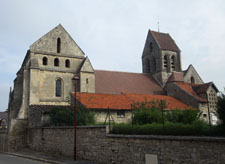Glennes (Aisne, France) - Saint-Georges
- Disclaimer
The dating found here is based on the work of John James, and is meant on this site to serve as a starting point. James' dating is derived from a system that uses his interpretation of the development of capitals over time as the basis for chronology, among other factors. His goal is to refine the dating to within years rather than decades. I have not fully embraced James' methodology, and will be developing this page from its current state to one which is admittedly more conservative. The relative expenditure values found in the Timeline are also based on James' work, and I believe these to be reasonably reliable. They are intended only to give a sense of the amount of work involved in each decade.
I have added the idea of the "project" as a way of separating work in buildings. In my mind, a "project" is a discrete section of work in a building that resulted from the one-time acquisition of funding. "Projects" are generally separated by at least a decade where no work was being done. It is my view that it would have been unwise to start a "project" that could not be finished and protected from the elements, and as such a "project" usually involved a wing or multiple wings of a building, from floor to roof. Rural churches, which could only secure small amounts of funding at irregular intervals, often were the result of many small projects, while the great churches, which benefitted from relatively consistent funding, may have involved only a few large projects.
I have added the idea of the "project" as a way of separating work in buildings. In my mind, a "project" is a discrete section of work in a building that resulted from the one-time acquisition of funding. "Projects" are generally separated by at least a decade where no work was being done. It is my view that it would have been unwise to start a "project" that could not be finished and protected from the elements, and as such a "project" usually involved a wing or multiple wings of a building, from floor to roof. Rural churches, which could only secure small amounts of funding at irregular intervals, often were the result of many small projects, while the great churches, which benefitted from relatively consistent funding, may have involved only a few large projects.
- Timeline with Relative Expenditure (if available, in building units)
 |
 |
 |
- Project A - Earlier - Phase 1 -
An existing church mentioned in 1157 document. The remnants of the lateral walls of the earlier church may have been left with new shafts encasing them.
- Project B - 1160s - Phase 2 - east (b)
W1 bases, though slightly different detail behind rib shaft, but as used the same 17cm plinth probably with apse; the flanking chapels have joints running vertically against apse, seen on outside to the start of the buttresses for the towers; axial apse and crossing in at least 6 campaigns.
- Project B - 1160s - Phase 3 - south-w
Capitals to south nave aisle entry on crossing side, also some to nave piers; built with apse window heads, but east not ready for vaults.
- Project B - 1160s - Phase 4 - north-w
Capitals to north nave aisle entry on crossing side, also some to nave piers.
- Project B - 1160s - Phase 5 - apse
Apse and crossing upper capitals and vaults both bays and entry arch
- Project B - 1160s - Phase 6 - s chapel (b)
South chapel (before north only because ground here is higher) with rectangular bases; built hard up against earlier apse and includes transept wall and capitals to south side of nave entry with arch over, and adjacent stairs.
- Project B - 1160s - Phase 7 - s chapel (a)
South chapel capitals and vaulted
- Project B - 1160s - Phase 8 - n chapel (b)
North chapel built hard up against earlier apse to plinths along transept wall for same bases as in apse; includes transept wall to north side of nave entry and arch over [if the same master built upper courses on each side (possible from caps and imposts, but not vault) then south vault was earlier, north later with a joint over north imposts]; the phases of construction were complex in many small steps.
- Project B - 1160s - Phase 9 - n chapel (a)
North chapel capitals and vaults; unlikely to have been one campaign to chapel vault and its entry arch.
- Project B - 1160s - Phase 10 - nave
Meantime, nave in small steps; caps and starter arches on aisle sides while two large square piers do not encase smaller ones as there is a corbel projecting on the south side of one.
- Project B - 1170s - Phase 11 - tower I, II
Two storey crossing tower with unfinished gable
- Project B - 1180s - Phase 12 - narthex (d)
Narthex with stairs and dado to arches over, includes capitals of entry into nave and west door.
- Project B - 1180s - Phase 13 - narthex (c)
Wall to clerestory capitals, sills of side windows and start of vault and gable over entry.
- Project B - 1180s - Phase 14 - narthex (v)
Upper wall with triplet oculi.
- Project B - 1180s - Phase 15 - narthex loft
Loft and gable roof with termination of buttresses.
